The Splinter Galaxy is a spiral galaxy located at an approximate distance of 46.5 million light-years in the northern constellation of Draco (the Dragon). It has an apparent magnitude of 11.1. It is also known as the Knife Edge Galaxy and listed as NGC 5907 in the New General Catalogue. The fainter western part of the galaxy is catalogued as NGC 5906.
The Splinter Galaxy appears edge-on. It has an angular size of 12.7 by 1.4 arcminutes, corresponding to a physical diameter of around 173,400 light-years. The galaxy is surrounded by a giant stellar stream, an association of stars that were once part of a smaller dwarf galaxy that was torn apart. The stars are now orbiting the larger galaxy.
The giant spiral galaxy was long believed to be a non-interacting, isolated, warped spiral galaxy. However, the discovery of a faint ring structure around NGC 5907 in 1998 cast the assumption of the galaxy’s isolation into doubt. A team led by Zhaohui Shang of the National Radio Astronomy Observatory (NRAO) in Charlottesville, Virginia, reported the detection of evidence of not one but two interactions with companion dwarf galaxies. The interaction is responsible for exciting the warp in the large galaxy’s disk.
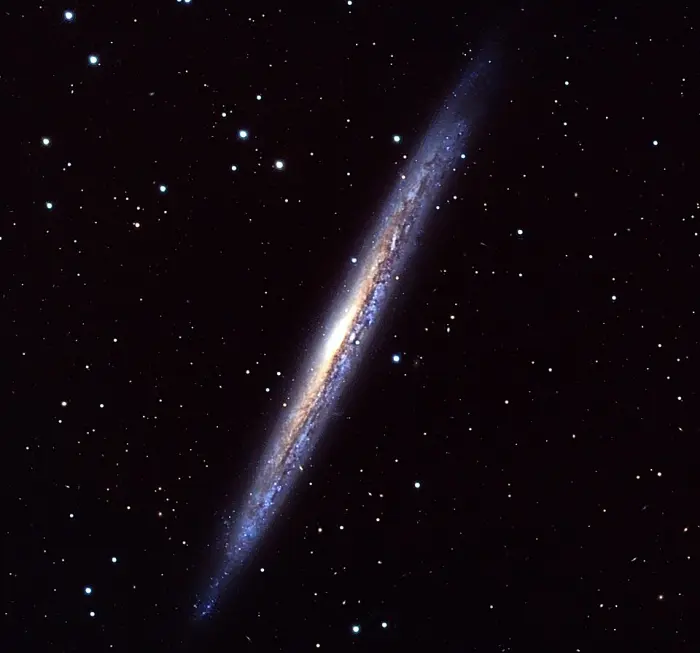
Splinter Galaxy (NGC 5907), image credit: Wikimedia Commons/Jschulman555 (CC BY 3.0)
The faint elliptical ring around the Splinter Galaxy is believed to be the result of tidal disruption of a smaller dwarf spheroidal galaxy. The ring is in orbit around NGC 5907. It has an angular size of 13.4 by 10.3, corresponding to a major axis size of about 43 kiloparsecs (140,247 light-years).
The galaxy’s centre falls close to the ring’s major axis. Observations with the Very Large Array (VLA) did not detect a gaseous component to the ring.
The astronomers also found a small companion to NGC 5907. The dwarf companion is catalogued as PGC 54419. It is estimated to be separated by only 120,352 light-years (36,900 parsecs) from the centre of the Splinter Galaxy. The smaller galaxy has a similar radial velocity to NGC 5907.
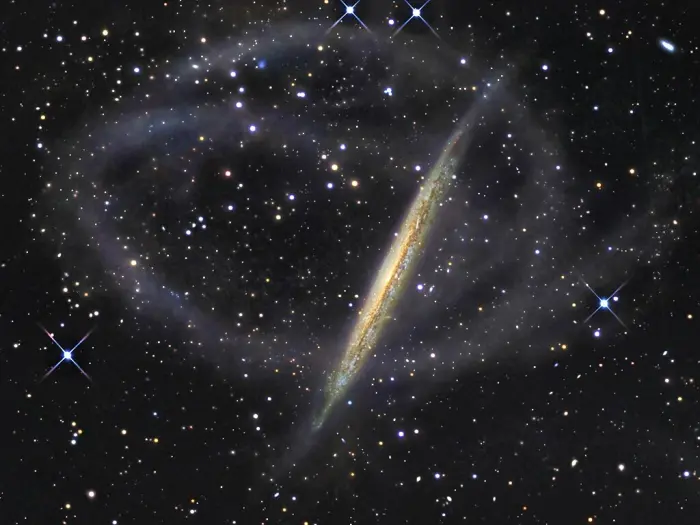
NGC 5907 and the faint stellar stream that loops it. Image credit: R. Jay GaBany (CC BY-SA 3.0)
The halo of the Splinter Galaxy has a very low metallicity and consists mostly of dwarf stars. In 2000, a team of astronomers led by Stephen E. Zepf, Department of Astronomy, Yale University, observed the galaxy with the Near Infrared Camera and Multi-Object Spectrometer (NICMOS) on board the NASA/ESA Hubble Space Telescope to resolve the bright giant stars in the galaxy’s halo. The scientists expected to find more than 100 giants. However, they found only one candidate giant star, indicating a metallicity as low as metal-poor globular clusters in the Milky Way.
The Splinter Galaxy is a member of the NGC 5907 Group (LGG 396). Also known as the NGC 5866 Group, the galaxy grouping includes the brighter lenticular galaxy popularly known as the Spindle Galaxy (Messier 102, NGC 5866) and the fainter unbarred spiral galaxy NGC 5879.
The group lies northwest of the M101 Group, centred on the bright Pinwheel Galaxy (Messier 101) in the constellation Ursa Major, and the M51 Group, named after the famous Whirlpool Galaxy (Messier 51) in Canes Venatici. The three galaxy groups lie at a similar distance and may be part of a single large, loose, elongated structure.
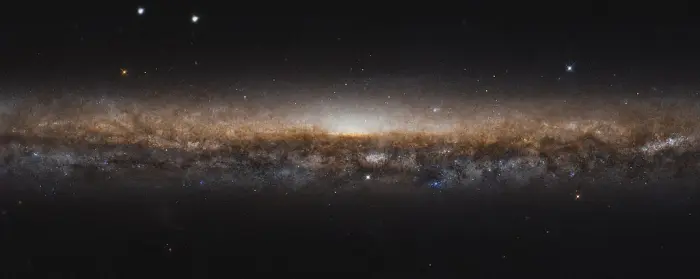
The galaxy known as NGC 5907 stretches wide across this image. Appearing as an elongated line of stars and dark dust, the galaxy is categorised as a spiral galaxy just like our own Milky Way. In this new image from the NASA/ESA Hubble Space Telescope, we don’t see the beautiful spiral arms because we are viewing it edge-on, like looking at the rim of a plate. It is for this reason that NGC 5907 is also known as the Knife Edge Galaxy.
The Knife Edge Galaxy is about 50 million light-years from Earth, lying in the northern constellation of Draco. Although not visible in this image, ghostly streams of stars on large arching loops extend into space, circling around the galaxy; they are believed to be remnants of a small dwarf galaxy, torn apart by the Knife Edge Galaxy and merged with it over four billion years ago. Credit: ESA/Hubble & NASA, R. de Jong; Acknowledgement: Judy Schmidt (CC BY 2.0)
Facts
The Splinter Galaxy was discovered by the German-born British astronomer William Herschel on May 5, 1788. Danish astronomer John Louis Emil Dreyer, who compiled the New General Catalogue (1888), described the galaxy as “considerably bright, very large, very much extended 155°, very gradually then pretty suddenly brighter middle and nucleus.”
The fainter western portion of the Splinter Galaxy was discovered by Irish physicist George Stoney on April 13, 1850. Dreyer included it in the New General Catalogue as NGC 5906 with the description “A ray, very much extended, parallel to h 1917 [NGC 5907] and close to the west of it.” The Danish astronomer credited William Parsons, 3rd Earl of Rosse, for the discovery because Stoney was employed by Lord Rosse at Birr Castle, County Offaly, Ireland, from 1848 to 1852.
The Splinter Galaxy hosted a supernova, SN 1940A, observed in 1940. SN 1940A was classified as a type II-L supernova and had an apparent magnitude of 14.3. It was discovered by Josef J. Johnson with the 18-inch Schmidt reflector at Palomar Observatory in California on February 16, 1940.
NGC 5907 hosts an ultraluminous X-ray source designated NGC 5907 ULX-1. The source shows a rapid pulsation effect with a period of 5.7 days and is also referred to as an ultraluminous X-ray pulsar (ULXP). It consists of a spinning neutron star – a remnant of a massive star – in orbit around a high-mass companion. The neutron star is believed to be accreting material from its massive companion.
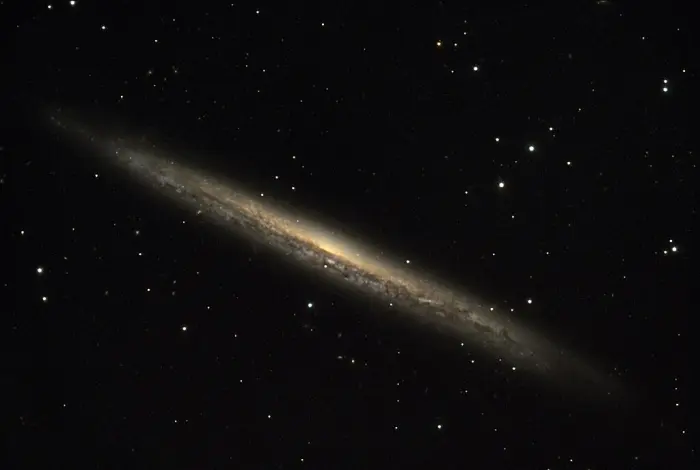
NGC 5907 is an edge-on spiral galaxy located about 50 million lightyears away from Earth in the constellation Draco.This image was taken as part of Advanced Observing Program (AOP) program at Kitt Peak Visitor Center during 2014. Credit: KPNO/NOIRLab/NSF/AURA/Brad Ehrhorn/Adam Block (CC BY 4.0)
Location
The Splinter Galaxy appears near the orange giant Edasich (Iota Draconis, mag. 3.29). Edasich is one of the relatively bright stars in the region between the Big Dipper’s handle and the Little Dipper’s bowl. It can be found by star hopping from Athebyne (Eta Draconis, mag. 2.73) and Theta Draconis (mag. 4.12). Athebyne can be found by extending a line from Kochab through Pherkad, the outer stars in the Little Dipper’s bowl.
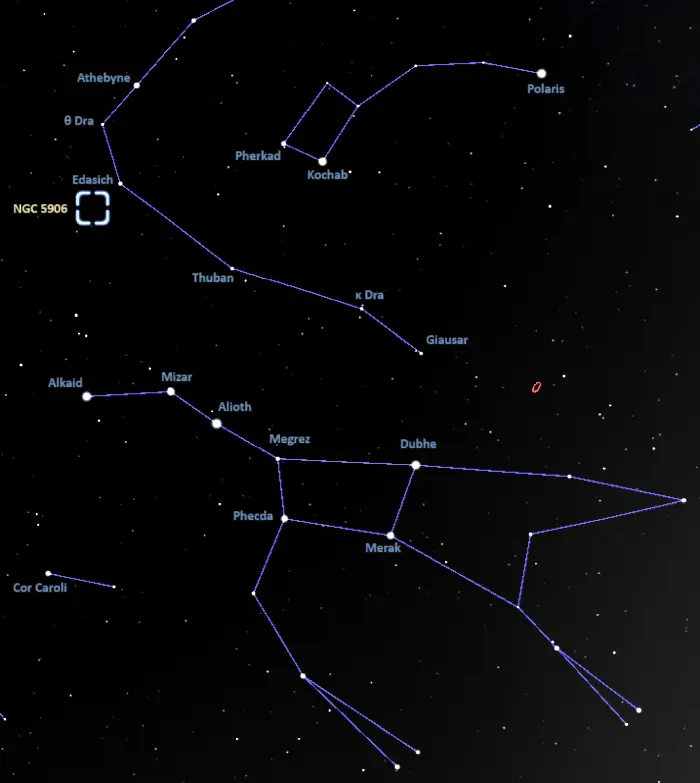
Location of the Splinter Galaxy (NGC 5907), image: Stellarium
NGC 5907 is separated by 86 arcminutes from the brighter Spindle Galaxy (M102), which appears roughly halfway between Athebyne in Draco and Alkaid in Ursa Major, about 4 degrees southwest of Edasich.
Other galaxies that appear in the same area include the spiral galaxies NGC 5879, NGC 5905, NGC 5908, and NGC 5965.
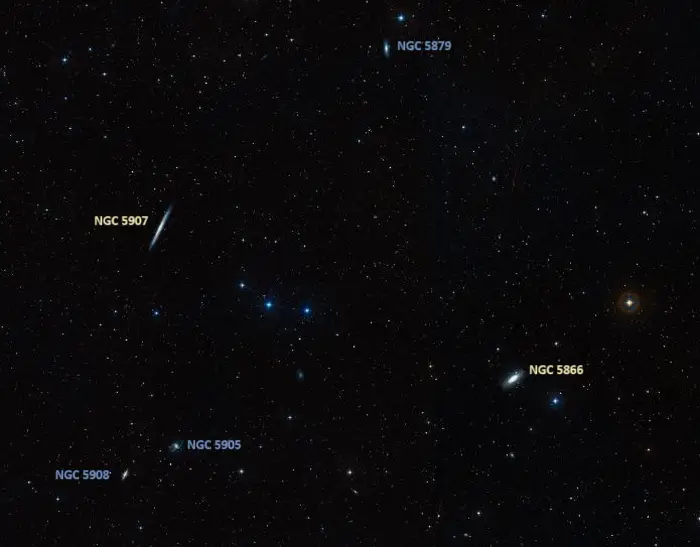
Splinter Galaxy (NGC 5907) and the Spindle Galaxy (NGC 5866), image credit: ESO/Digitized Sky Survey 2 (CC BY 4.0)
At declination +56°, the Splinter Galaxy is best seen from the northern hemisphere. It never rises for observers south of the latitude 33° S.
The best time of the year to observe the Splinter Galaxy and other deep sky objects in Draco is during the month of July, when the constellation is high above the horizon in the early evening. For northern observers, Draco is visible throughout the year.
Splinter Galaxy – NGC 5907
| Constellation | Draco |
| Object type | Spiral galaxy |
| Morphological type | SA(s)c? |
| Right ascension | 15h 15m 53.2397s |
| Declination | +56° 19′ 47.568″ |
| Apparent magnitude | 11.1 |
| Apparent size | 12.7′ × 1.4′ |
| Distance | 46.56 ± 1.77 million light-years (14.275 ± 0.543 megaparsecs) |
| Redshift | 0.002227 |
| Heliocentric radial velocity | 667 km/s |
| Surface brightness | 23.6 mag/arcsec2 |
| Size | ~173,400 light-years (53,150 parsecs) |
| Names and designations | Splinter Galaxy, Knife Edge Galaxy, NGC 5906, NGC 5907, PGC 54470, LEDA 54470, UGC 9801, MCG +09-25-040, HOLM 704A, IRAS 15146+5629, IRAS F15145+5630, 2MASX J15155368+5619438, CGCG 274-038, FGC 1875, ISOSS J15159+5617, 2MFGC 12346, PSCz Q15146+5629, Z 274-38, Z 297-10, Z 1514.6+5630, SDSS J151553.83+561943.0, SDSS J151553.77+561943.6, SDSS J151553.77+561943.5, UZC J151554.0+561946, RFGC 2946 |
Images
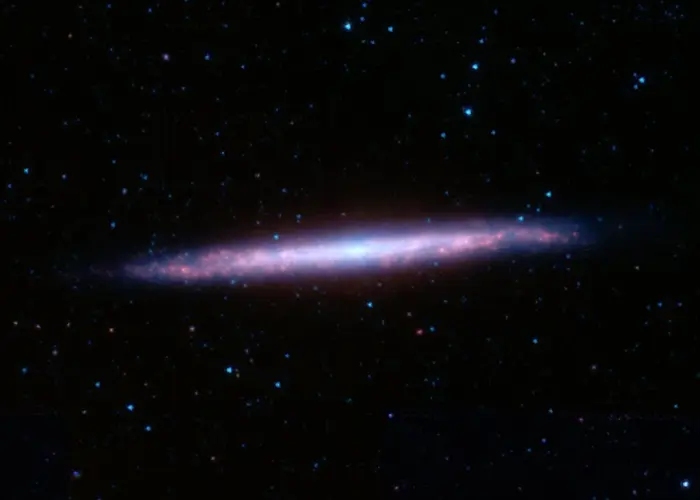
The spiral galaxy NGC 5907, sometimes known as the “Splinter Galaxy” because of its unusual appearance, is located in the constellation Draco. It is fairly bright, and appears elongated because it has an edge-on alignment when viewed from Earth. It also has a strong set of dust lanes, visible in this image from NASA’s Spitzer Space Telescope as red features. The central lane is so pronounced at visible light wavelengths, where it blocks our view of the starlight, that the galaxy was once mistaken for two objects and given two entries in the original New General Catalogue. The catalogue, published by J. L. E. Dreyer in 1888, was an attempt to collect a complete list of all nebulae and star clusters known at the time. Credit: NASA/JPL-Caltech/M.L.N. Ashby (Harvard-Smithsonian CfA) (PD)
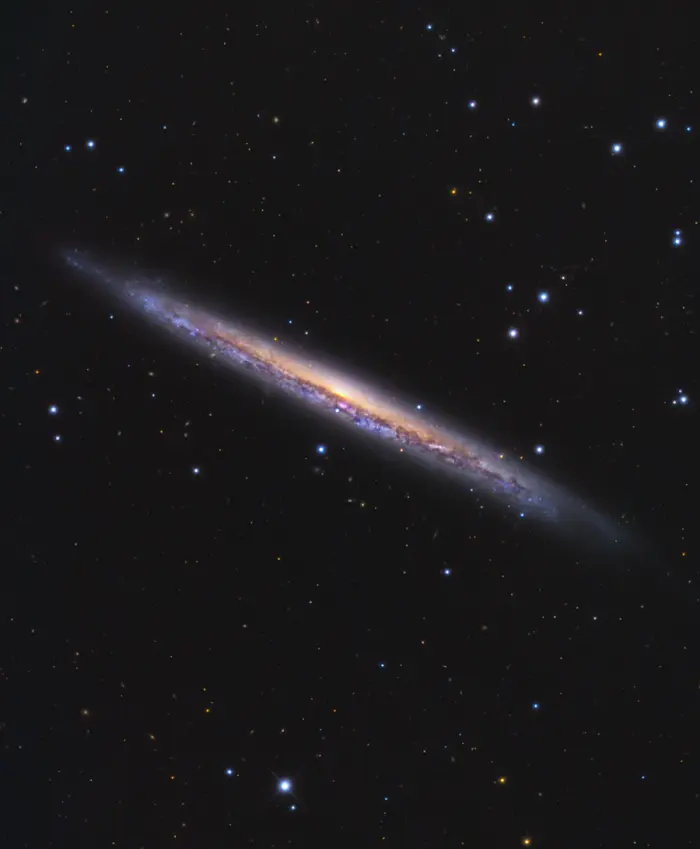
Splinter Galaxy (NGC 5907), image credit: Adam Block/Mount Lemmon SkyCenter/University of Arizona (CC BY-SA 3.0 US)